ACC518: Current Developments in Accounting Thoughts Analysis
VerifiedAdded on 2022/11/24
|28
|3823
|291
Homework Assignment
AI Summary
This assignment analyzes current developments in accounting, focusing on two key questions. The first question examines a news article concerning Pioneer Credit Ltd's accounting practices, specifically their use of fair value accounting for debt portfolios, which led to disputes with the Australian Securities and Investment Commission (ASIC). The analysis connects these issues to accounting theories, particularly the stakeholder theory, emphasizing the importance of considering all stakeholders' interests. The second question analyzes an exposure draft related to IAS 37 Provisions, Contingent Liabilities and Contingent Assets, specifically focusing on onerous contracts. It evaluates comments from four respondents regarding the proposed amendments, including the costs of fulfilling a contract, and assesses whether their views align with the draft's recommendations. The report provides a critical evaluation of the theories included in the exposure draft, focusing on consistency in accounting standards.
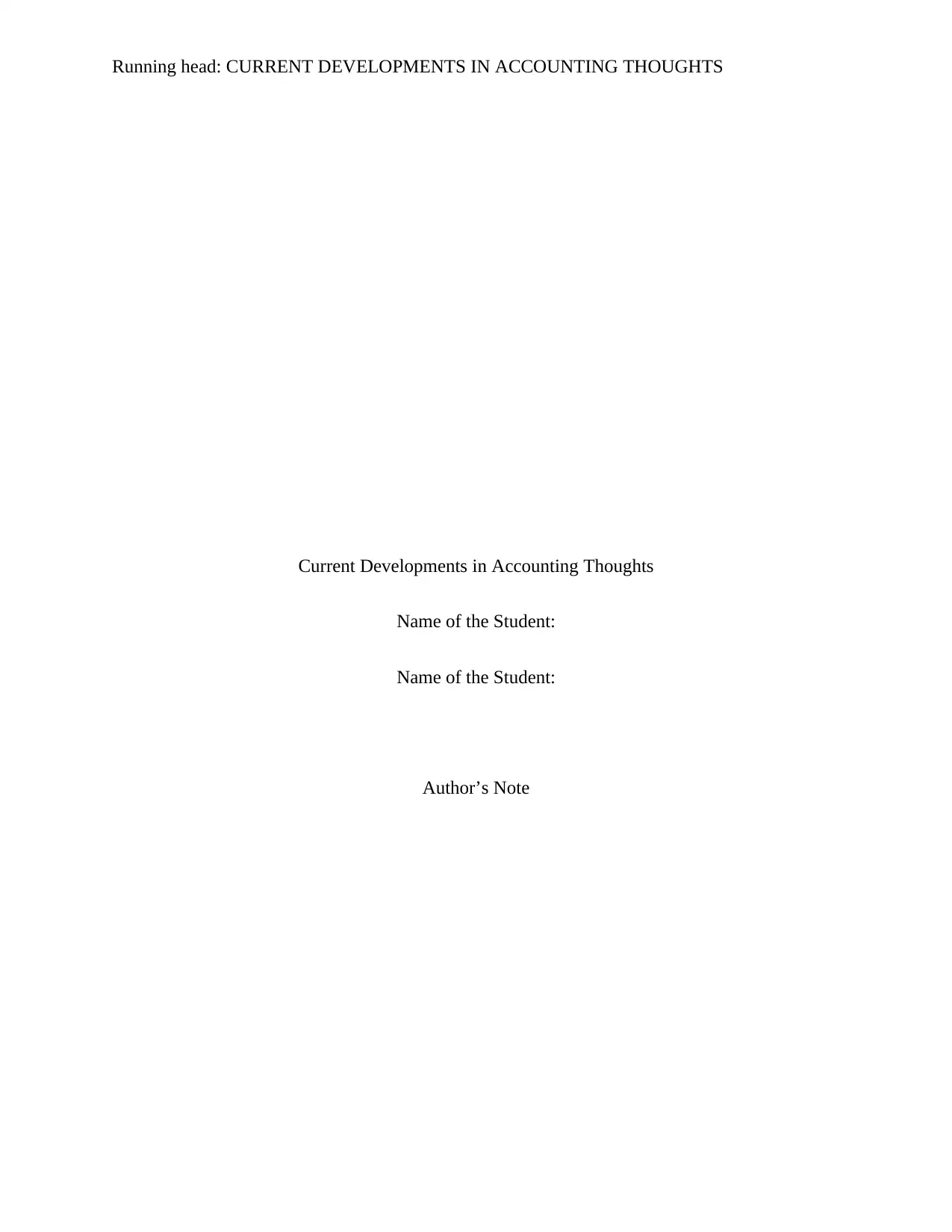
Running head: CURRENT DEVELOPMENTS IN ACCOUNTING THOUGHTS
Current Developments in Accounting Thoughts
Name of the Student:
Name of the Student:
Author’s Note
Current Developments in Accounting Thoughts
Name of the Student:
Name of the Student:
Author’s Note
Paraphrase This Document
Need a fresh take? Get an instant paraphrase of this document with our AI Paraphraser
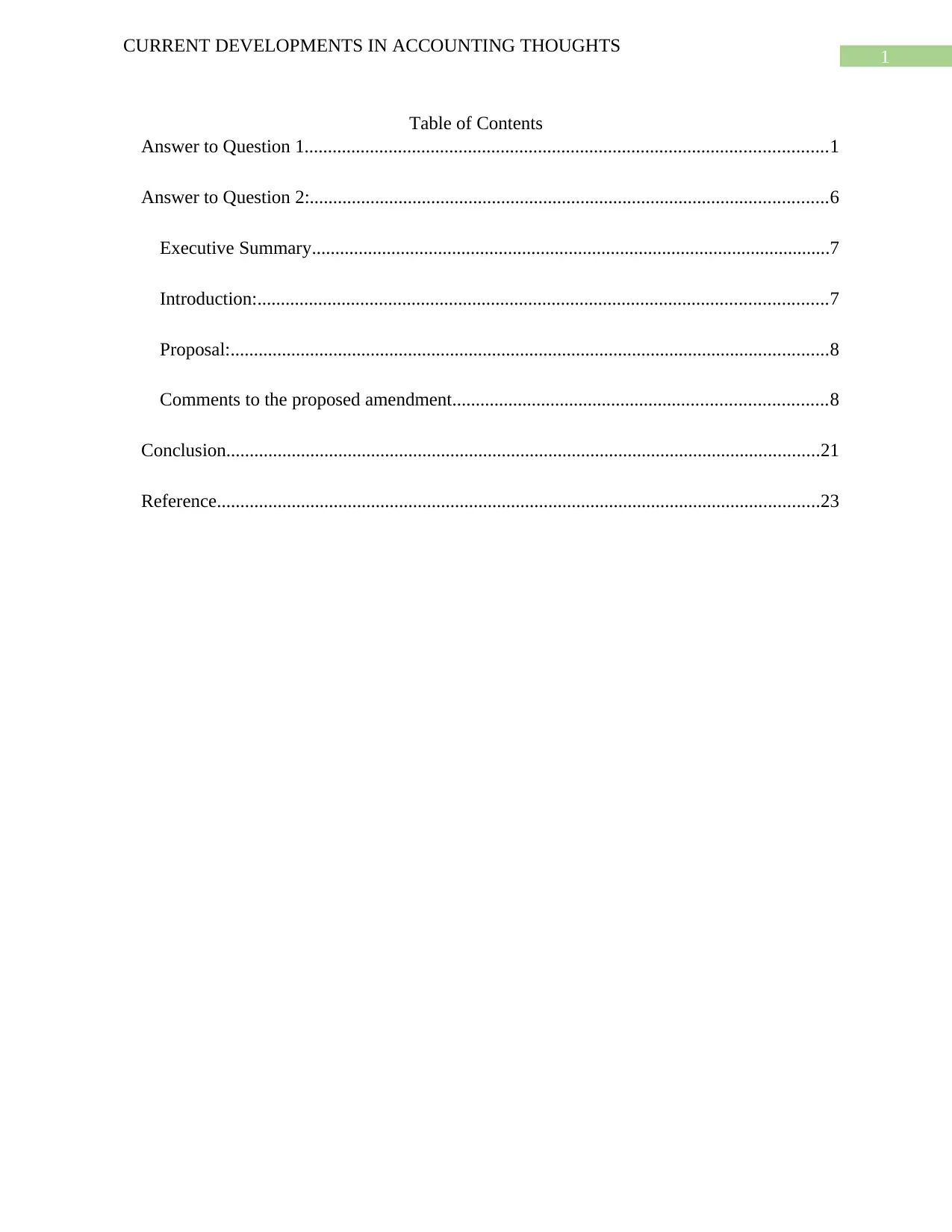
1
CURRENT DEVELOPMENTS IN ACCOUNTING THOUGHTS
Table of Contents
Answer to Question 1................................................................................................................1
Answer to Question 2:...............................................................................................................6
Executive Summary...............................................................................................................7
Introduction:..........................................................................................................................7
Proposal:................................................................................................................................8
Comments to the proposed amendment................................................................................8
Conclusion...............................................................................................................................21
Reference.................................................................................................................................23
CURRENT DEVELOPMENTS IN ACCOUNTING THOUGHTS
Table of Contents
Answer to Question 1................................................................................................................1
Answer to Question 2:...............................................................................................................6
Executive Summary...............................................................................................................7
Introduction:..........................................................................................................................7
Proposal:................................................................................................................................8
Comments to the proposed amendment................................................................................8
Conclusion...............................................................................................................................21
Reference.................................................................................................................................23
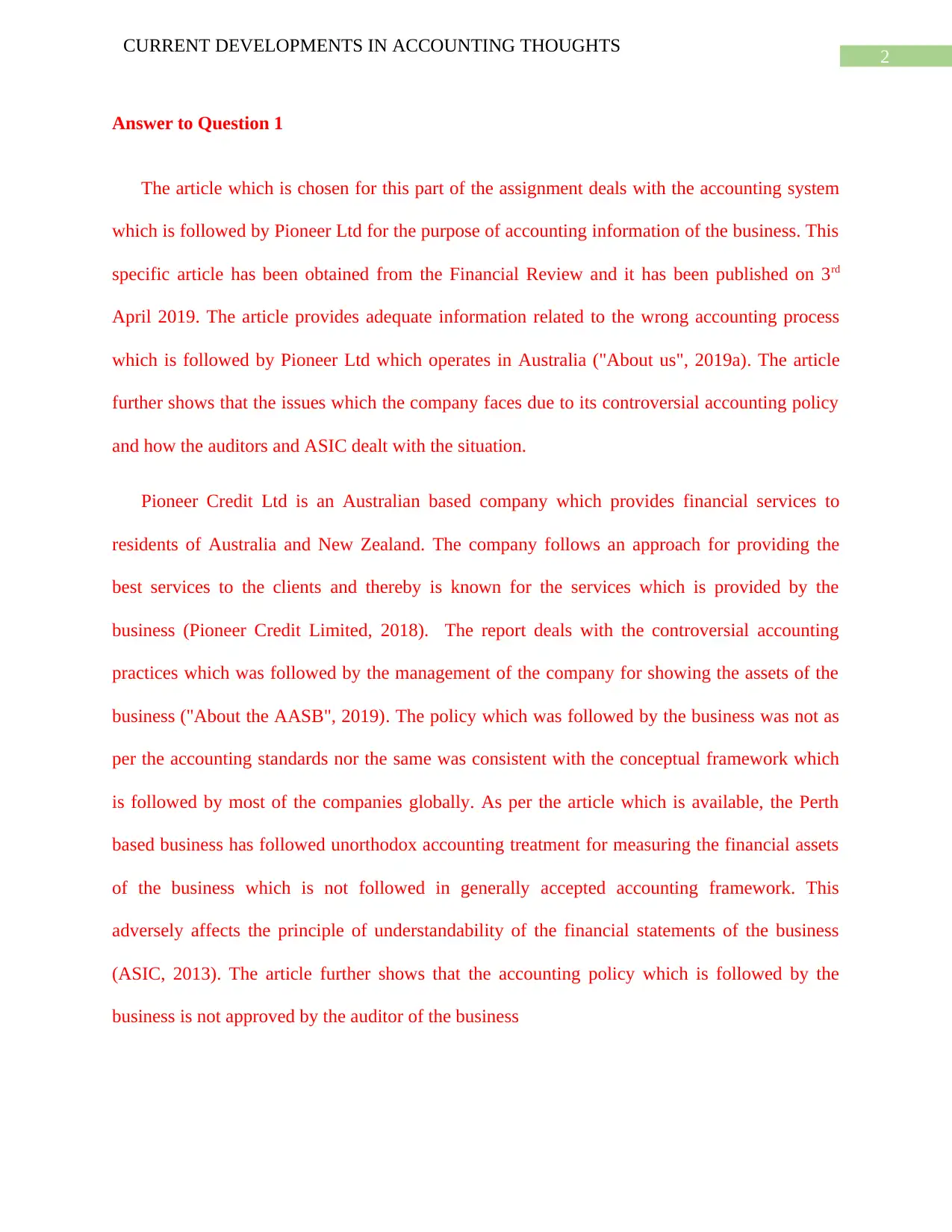
2
CURRENT DEVELOPMENTS IN ACCOUNTING THOUGHTS
Answer to Question 1
The article which is chosen for this part of the assignment deals with the accounting system
which is followed by Pioneer Ltd for the purpose of accounting information of the business. This
specific article has been obtained from the Financial Review and it has been published on 3rd
April 2019. The article provides adequate information related to the wrong accounting process
which is followed by Pioneer Ltd which operates in Australia ("About us", 2019a). The article
further shows that the issues which the company faces due to its controversial accounting policy
and how the auditors and ASIC dealt with the situation.
Pioneer Credit Ltd is an Australian based company which provides financial services to
residents of Australia and New Zealand. The company follows an approach for providing the
best services to the clients and thereby is known for the services which is provided by the
business (Pioneer Credit Limited, 2018). The report deals with the controversial accounting
practices which was followed by the management of the company for showing the assets of the
business ("About the AASB", 2019). The policy which was followed by the business was not as
per the accounting standards nor the same was consistent with the conceptual framework which
is followed by most of the companies globally. As per the article which is available, the Perth
based business has followed unorthodox accounting treatment for measuring the financial assets
of the business which is not followed in generally accepted accounting framework. This
adversely affects the principle of understandability of the financial statements of the business
(ASIC, 2013). The article further shows that the accounting policy which is followed by the
business is not approved by the auditor of the business
CURRENT DEVELOPMENTS IN ACCOUNTING THOUGHTS
Answer to Question 1
The article which is chosen for this part of the assignment deals with the accounting system
which is followed by Pioneer Ltd for the purpose of accounting information of the business. This
specific article has been obtained from the Financial Review and it has been published on 3rd
April 2019. The article provides adequate information related to the wrong accounting process
which is followed by Pioneer Ltd which operates in Australia ("About us", 2019a). The article
further shows that the issues which the company faces due to its controversial accounting policy
and how the auditors and ASIC dealt with the situation.
Pioneer Credit Ltd is an Australian based company which provides financial services to
residents of Australia and New Zealand. The company follows an approach for providing the
best services to the clients and thereby is known for the services which is provided by the
business (Pioneer Credit Limited, 2018). The report deals with the controversial accounting
practices which was followed by the management of the company for showing the assets of the
business ("About the AASB", 2019). The policy which was followed by the business was not as
per the accounting standards nor the same was consistent with the conceptual framework which
is followed by most of the companies globally. As per the article which is available, the Perth
based business has followed unorthodox accounting treatment for measuring the financial assets
of the business which is not followed in generally accepted accounting framework. This
adversely affects the principle of understandability of the financial statements of the business
(ASIC, 2013). The article further shows that the accounting policy which is followed by the
business is not approved by the auditor of the business
⊘ This is a preview!⊘
Do you want full access?
Subscribe today to unlock all pages.

Trusted by 1+ million students worldwide
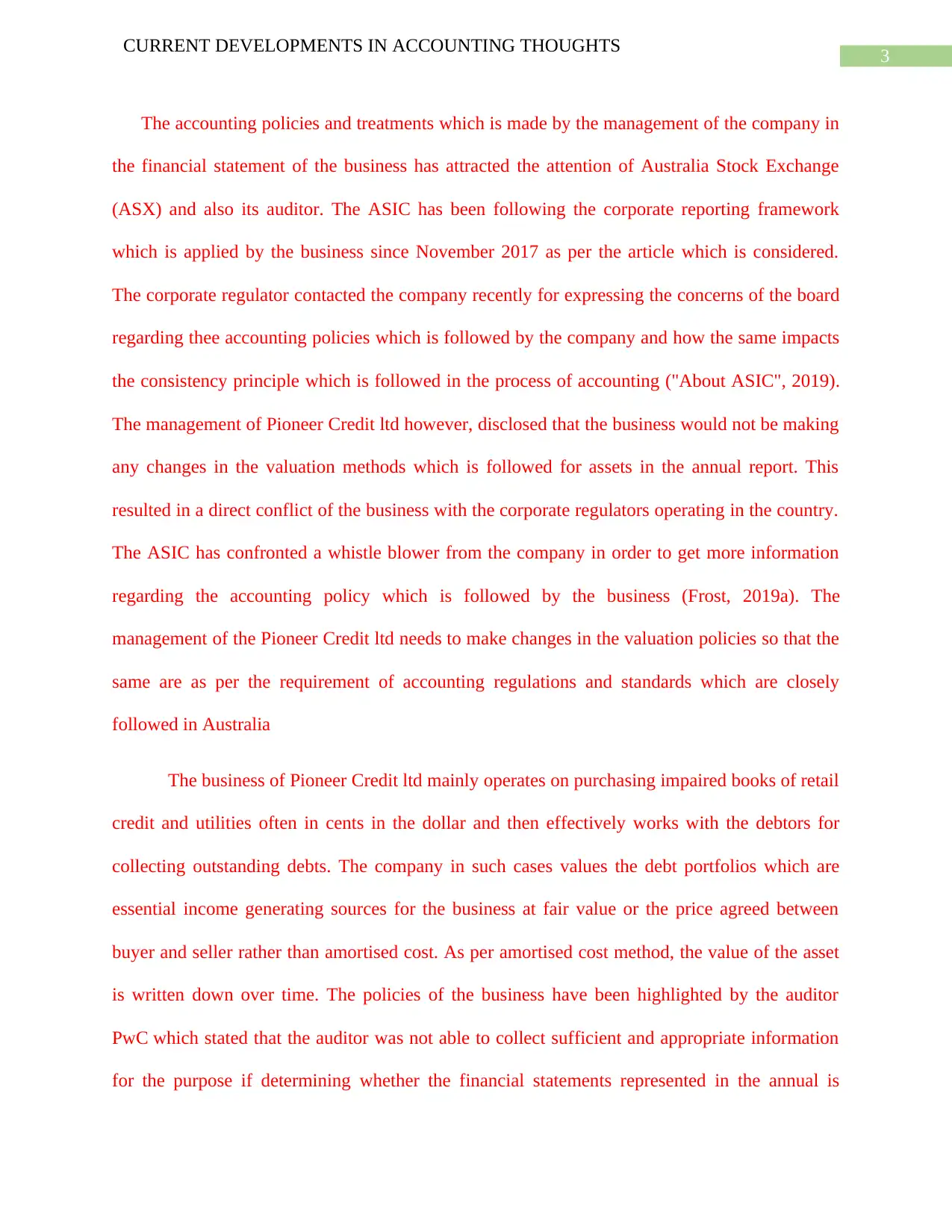
3
CURRENT DEVELOPMENTS IN ACCOUNTING THOUGHTS
The accounting policies and treatments which is made by the management of the company in
the financial statement of the business has attracted the attention of Australia Stock Exchange
(ASX) and also its auditor. The ASIC has been following the corporate reporting framework
which is applied by the business since November 2017 as per the article which is considered.
The corporate regulator contacted the company recently for expressing the concerns of the board
regarding thee accounting policies which is followed by the company and how the same impacts
the consistency principle which is followed in the process of accounting ("About ASIC", 2019).
The management of Pioneer Credit ltd however, disclosed that the business would not be making
any changes in the valuation methods which is followed for assets in the annual report. This
resulted in a direct conflict of the business with the corporate regulators operating in the country.
The ASIC has confronted a whistle blower from the company in order to get more information
regarding the accounting policy which is followed by the business (Frost, 2019a). The
management of the Pioneer Credit ltd needs to make changes in the valuation policies so that the
same are as per the requirement of accounting regulations and standards which are closely
followed in Australia
The business of Pioneer Credit ltd mainly operates on purchasing impaired books of retail
credit and utilities often in cents in the dollar and then effectively works with the debtors for
collecting outstanding debts. The company in such cases values the debt portfolios which are
essential income generating sources for the business at fair value or the price agreed between
buyer and seller rather than amortised cost. As per amortised cost method, the value of the asset
is written down over time. The policies of the business have been highlighted by the auditor
PwC which stated that the auditor was not able to collect sufficient and appropriate information
for the purpose if determining whether the financial statements represented in the annual is
CURRENT DEVELOPMENTS IN ACCOUNTING THOUGHTS
The accounting policies and treatments which is made by the management of the company in
the financial statement of the business has attracted the attention of Australia Stock Exchange
(ASX) and also its auditor. The ASIC has been following the corporate reporting framework
which is applied by the business since November 2017 as per the article which is considered.
The corporate regulator contacted the company recently for expressing the concerns of the board
regarding thee accounting policies which is followed by the company and how the same impacts
the consistency principle which is followed in the process of accounting ("About ASIC", 2019).
The management of Pioneer Credit ltd however, disclosed that the business would not be making
any changes in the valuation methods which is followed for assets in the annual report. This
resulted in a direct conflict of the business with the corporate regulators operating in the country.
The ASIC has confronted a whistle blower from the company in order to get more information
regarding the accounting policy which is followed by the business (Frost, 2019a). The
management of the Pioneer Credit ltd needs to make changes in the valuation policies so that the
same are as per the requirement of accounting regulations and standards which are closely
followed in Australia
The business of Pioneer Credit ltd mainly operates on purchasing impaired books of retail
credit and utilities often in cents in the dollar and then effectively works with the debtors for
collecting outstanding debts. The company in such cases values the debt portfolios which are
essential income generating sources for the business at fair value or the price agreed between
buyer and seller rather than amortised cost. As per amortised cost method, the value of the asset
is written down over time. The policies of the business have been highlighted by the auditor
PwC which stated that the auditor was not able to collect sufficient and appropriate information
for the purpose if determining whether the financial statements represented in the annual is
Paraphrase This Document
Need a fresh take? Get an instant paraphrase of this document with our AI Paraphraser
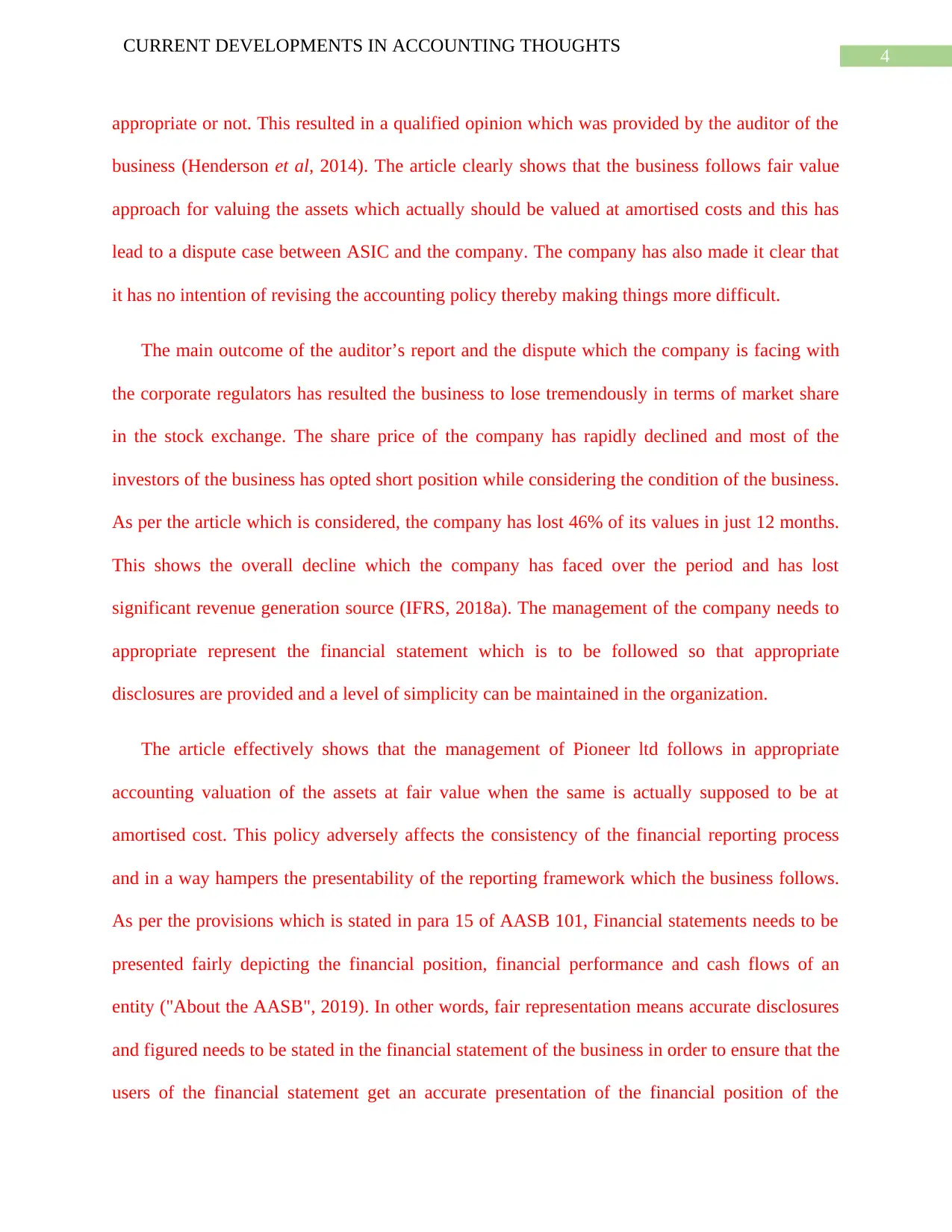
4
CURRENT DEVELOPMENTS IN ACCOUNTING THOUGHTS
appropriate or not. This resulted in a qualified opinion which was provided by the auditor of the
business (Henderson et al, 2014). The article clearly shows that the business follows fair value
approach for valuing the assets which actually should be valued at amortised costs and this has
lead to a dispute case between ASIC and the company. The company has also made it clear that
it has no intention of revising the accounting policy thereby making things more difficult.
The main outcome of the auditor’s report and the dispute which the company is facing with
the corporate regulators has resulted the business to lose tremendously in terms of market share
in the stock exchange. The share price of the company has rapidly declined and most of the
investors of the business has opted short position while considering the condition of the business.
As per the article which is considered, the company has lost 46% of its values in just 12 months.
This shows the overall decline which the company has faced over the period and has lost
significant revenue generation source (IFRS, 2018a). The management of the company needs to
appropriate represent the financial statement which is to be followed so that appropriate
disclosures are provided and a level of simplicity can be maintained in the organization.
The article effectively shows that the management of Pioneer ltd follows in appropriate
accounting valuation of the assets at fair value when the same is actually supposed to be at
amortised cost. This policy adversely affects the consistency of the financial reporting process
and in a way hampers the presentability of the reporting framework which the business follows.
As per the provisions which is stated in para 15 of AASB 101, Financial statements needs to be
presented fairly depicting the financial position, financial performance and cash flows of an
entity ("About the AASB", 2019). In other words, fair representation means accurate disclosures
and figured needs to be stated in the financial statement of the business in order to ensure that the
users of the financial statement get an accurate presentation of the financial position of the
CURRENT DEVELOPMENTS IN ACCOUNTING THOUGHTS
appropriate or not. This resulted in a qualified opinion which was provided by the auditor of the
business (Henderson et al, 2014). The article clearly shows that the business follows fair value
approach for valuing the assets which actually should be valued at amortised costs and this has
lead to a dispute case between ASIC and the company. The company has also made it clear that
it has no intention of revising the accounting policy thereby making things more difficult.
The main outcome of the auditor’s report and the dispute which the company is facing with
the corporate regulators has resulted the business to lose tremendously in terms of market share
in the stock exchange. The share price of the company has rapidly declined and most of the
investors of the business has opted short position while considering the condition of the business.
As per the article which is considered, the company has lost 46% of its values in just 12 months.
This shows the overall decline which the company has faced over the period and has lost
significant revenue generation source (IFRS, 2018a). The management of the company needs to
appropriate represent the financial statement which is to be followed so that appropriate
disclosures are provided and a level of simplicity can be maintained in the organization.
The article effectively shows that the management of Pioneer ltd follows in appropriate
accounting valuation of the assets at fair value when the same is actually supposed to be at
amortised cost. This policy adversely affects the consistency of the financial reporting process
and in a way hampers the presentability of the reporting framework which the business follows.
As per the provisions which is stated in para 15 of AASB 101, Financial statements needs to be
presented fairly depicting the financial position, financial performance and cash flows of an
entity ("About the AASB", 2019). In other words, fair representation means accurate disclosures
and figured needs to be stated in the financial statement of the business in order to ensure that the
users of the financial statement get an accurate presentation of the financial position of the
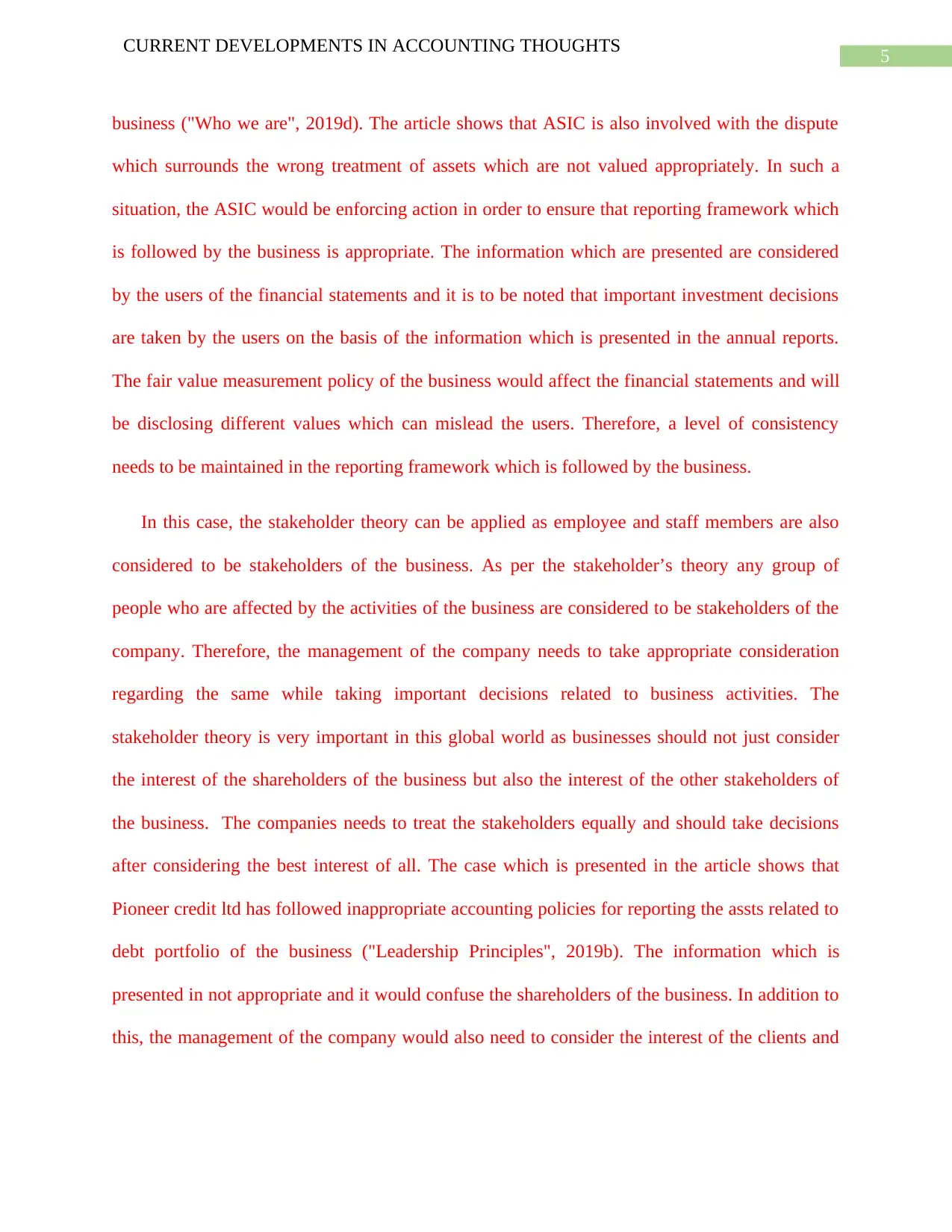
5
CURRENT DEVELOPMENTS IN ACCOUNTING THOUGHTS
business ("Who we are", 2019d). The article shows that ASIC is also involved with the dispute
which surrounds the wrong treatment of assets which are not valued appropriately. In such a
situation, the ASIC would be enforcing action in order to ensure that reporting framework which
is followed by the business is appropriate. The information which are presented are considered
by the users of the financial statements and it is to be noted that important investment decisions
are taken by the users on the basis of the information which is presented in the annual reports.
The fair value measurement policy of the business would affect the financial statements and will
be disclosing different values which can mislead the users. Therefore, a level of consistency
needs to be maintained in the reporting framework which is followed by the business.
In this case, the stakeholder theory can be applied as employee and staff members are also
considered to be stakeholders of the business. As per the stakeholder’s theory any group of
people who are affected by the activities of the business are considered to be stakeholders of the
company. Therefore, the management of the company needs to take appropriate consideration
regarding the same while taking important decisions related to business activities. The
stakeholder theory is very important in this global world as businesses should not just consider
the interest of the shareholders of the business but also the interest of the other stakeholders of
the business. The companies needs to treat the stakeholders equally and should take decisions
after considering the best interest of all. The case which is presented in the article shows that
Pioneer credit ltd has followed inappropriate accounting policies for reporting the assts related to
debt portfolio of the business ("Leadership Principles", 2019b). The information which is
presented in not appropriate and it would confuse the shareholders of the business. In addition to
this, the management of the company would also need to consider the interest of the clients and
CURRENT DEVELOPMENTS IN ACCOUNTING THOUGHTS
business ("Who we are", 2019d). The article shows that ASIC is also involved with the dispute
which surrounds the wrong treatment of assets which are not valued appropriately. In such a
situation, the ASIC would be enforcing action in order to ensure that reporting framework which
is followed by the business is appropriate. The information which are presented are considered
by the users of the financial statements and it is to be noted that important investment decisions
are taken by the users on the basis of the information which is presented in the annual reports.
The fair value measurement policy of the business would affect the financial statements and will
be disclosing different values which can mislead the users. Therefore, a level of consistency
needs to be maintained in the reporting framework which is followed by the business.
In this case, the stakeholder theory can be applied as employee and staff members are also
considered to be stakeholders of the business. As per the stakeholder’s theory any group of
people who are affected by the activities of the business are considered to be stakeholders of the
company. Therefore, the management of the company needs to take appropriate consideration
regarding the same while taking important decisions related to business activities. The
stakeholder theory is very important in this global world as businesses should not just consider
the interest of the shareholders of the business but also the interest of the other stakeholders of
the business. The companies needs to treat the stakeholders equally and should take decisions
after considering the best interest of all. The case which is presented in the article shows that
Pioneer credit ltd has followed inappropriate accounting policies for reporting the assts related to
debt portfolio of the business ("Leadership Principles", 2019b). The information which is
presented in not appropriate and it would confuse the shareholders of the business. In addition to
this, the management of the company would also need to consider the interest of the clients and
⊘ This is a preview!⊘
Do you want full access?
Subscribe today to unlock all pages.

Trusted by 1+ million students worldwide
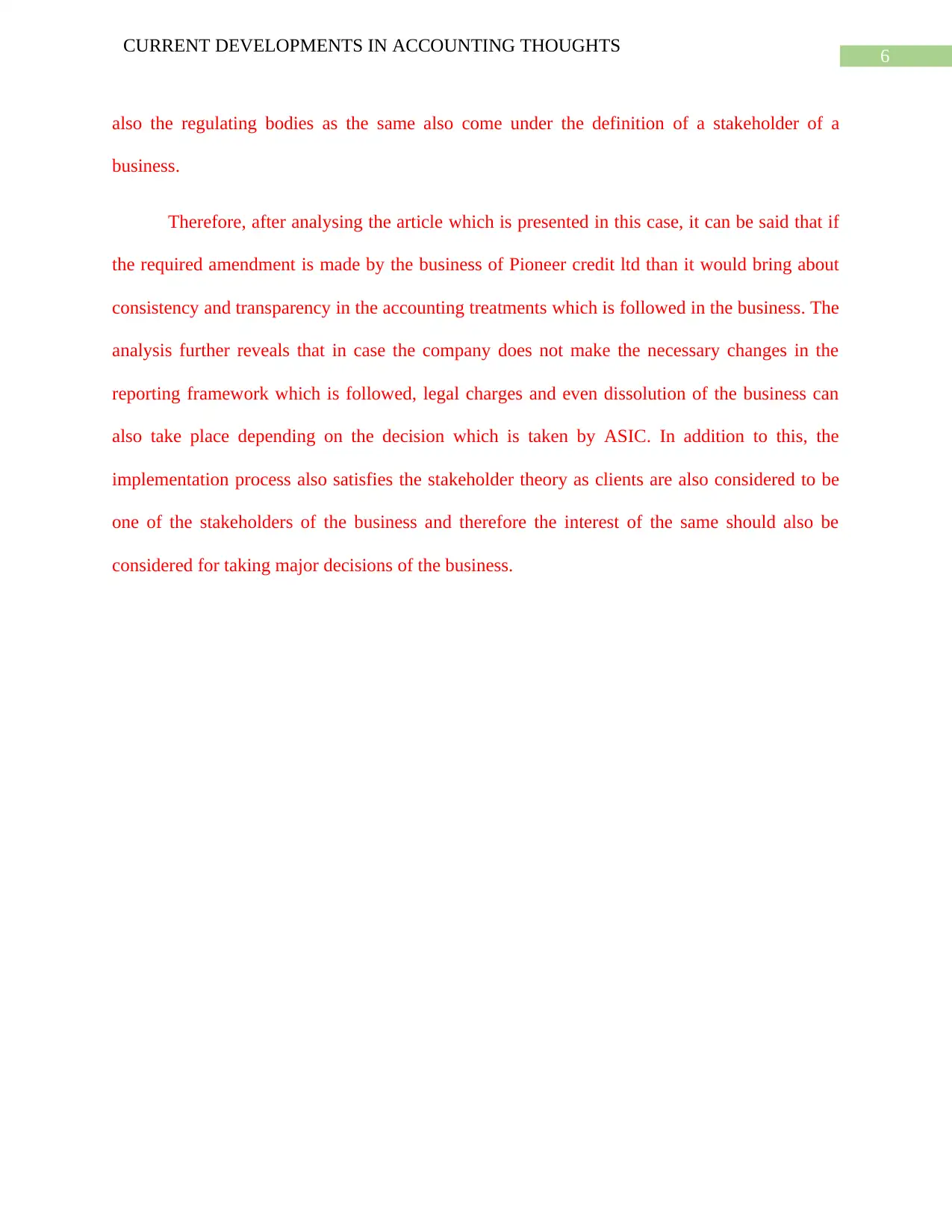
6
CURRENT DEVELOPMENTS IN ACCOUNTING THOUGHTS
also the regulating bodies as the same also come under the definition of a stakeholder of a
business.
Therefore, after analysing the article which is presented in this case, it can be said that if
the required amendment is made by the business of Pioneer credit ltd than it would bring about
consistency and transparency in the accounting treatments which is followed in the business. The
analysis further reveals that in case the company does not make the necessary changes in the
reporting framework which is followed, legal charges and even dissolution of the business can
also take place depending on the decision which is taken by ASIC. In addition to this, the
implementation process also satisfies the stakeholder theory as clients are also considered to be
one of the stakeholders of the business and therefore the interest of the same should also be
considered for taking major decisions of the business.
CURRENT DEVELOPMENTS IN ACCOUNTING THOUGHTS
also the regulating bodies as the same also come under the definition of a stakeholder of a
business.
Therefore, after analysing the article which is presented in this case, it can be said that if
the required amendment is made by the business of Pioneer credit ltd than it would bring about
consistency and transparency in the accounting treatments which is followed in the business. The
analysis further reveals that in case the company does not make the necessary changes in the
reporting framework which is followed, legal charges and even dissolution of the business can
also take place depending on the decision which is taken by ASIC. In addition to this, the
implementation process also satisfies the stakeholder theory as clients are also considered to be
one of the stakeholders of the business and therefore the interest of the same should also be
considered for taking major decisions of the business.
Paraphrase This Document
Need a fresh take? Get an instant paraphrase of this document with our AI Paraphraser
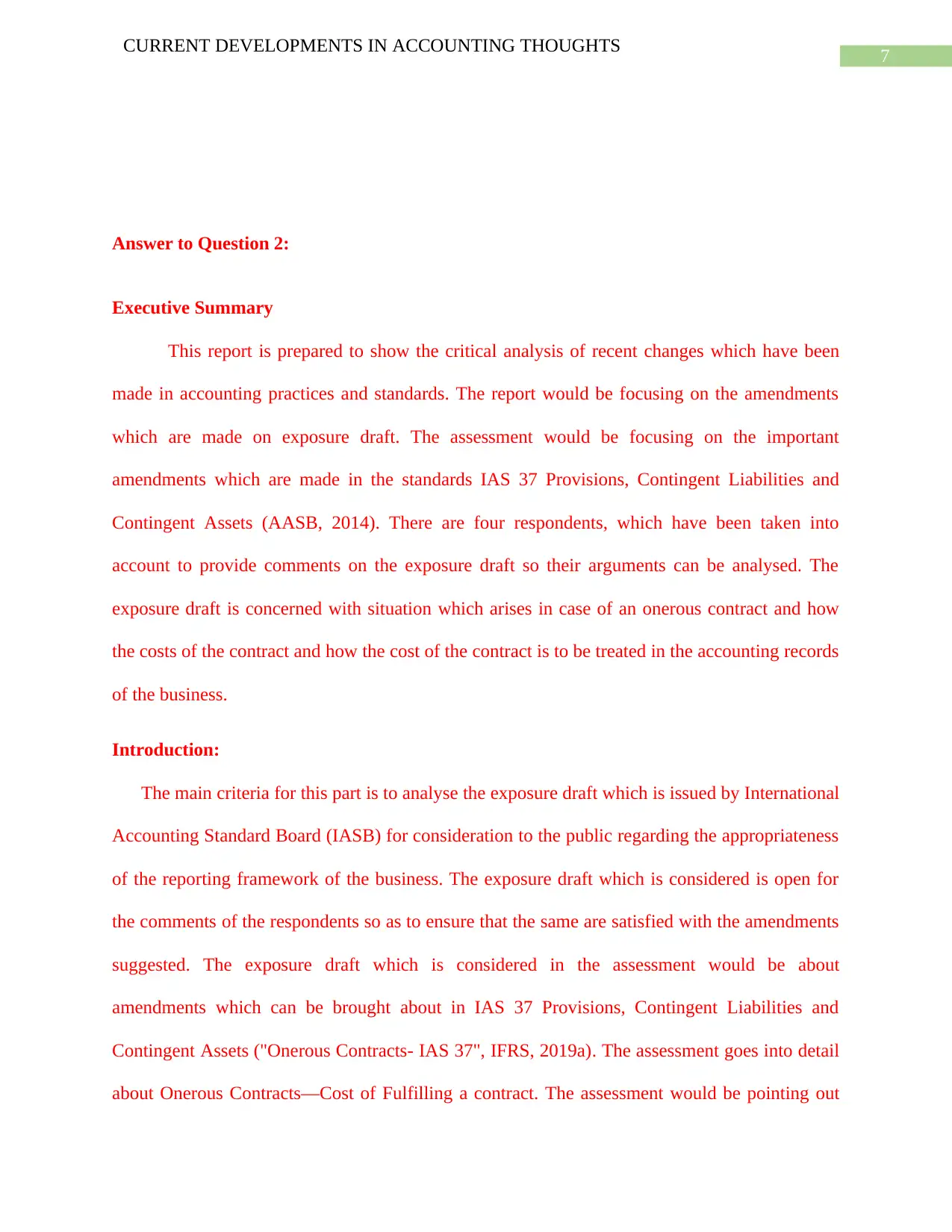
7
CURRENT DEVELOPMENTS IN ACCOUNTING THOUGHTS
Answer to Question 2:
Executive Summary
This report is prepared to show the critical analysis of recent changes which have been
made in accounting practices and standards. The report would be focusing on the amendments
which are made on exposure draft. The assessment would be focusing on the important
amendments which are made in the standards IAS 37 Provisions, Contingent Liabilities and
Contingent Assets (AASB, 2014). There are four respondents, which have been taken into
account to provide comments on the exposure draft so their arguments can be analysed. The
exposure draft is concerned with situation which arises in case of an onerous contract and how
the costs of the contract and how the cost of the contract is to be treated in the accounting records
of the business.
Introduction:
The main criteria for this part is to analyse the exposure draft which is issued by International
Accounting Standard Board (IASB) for consideration to the public regarding the appropriateness
of the reporting framework of the business. The exposure draft which is considered is open for
the comments of the respondents so as to ensure that the same are satisfied with the amendments
suggested. The exposure draft which is considered in the assessment would be about
amendments which can be brought about in IAS 37 Provisions, Contingent Liabilities and
Contingent Assets ("Onerous Contracts- IAS 37", IFRS, 2019a). The assessment goes into detail
about Onerous Contracts—Cost of Fulfilling a contract. The assessment would be pointing out
CURRENT DEVELOPMENTS IN ACCOUNTING THOUGHTS
Answer to Question 2:
Executive Summary
This report is prepared to show the critical analysis of recent changes which have been
made in accounting practices and standards. The report would be focusing on the amendments
which are made on exposure draft. The assessment would be focusing on the important
amendments which are made in the standards IAS 37 Provisions, Contingent Liabilities and
Contingent Assets (AASB, 2014). There are four respondents, which have been taken into
account to provide comments on the exposure draft so their arguments can be analysed. The
exposure draft is concerned with situation which arises in case of an onerous contract and how
the costs of the contract and how the cost of the contract is to be treated in the accounting records
of the business.
Introduction:
The main criteria for this part is to analyse the exposure draft which is issued by International
Accounting Standard Board (IASB) for consideration to the public regarding the appropriateness
of the reporting framework of the business. The exposure draft which is considered is open for
the comments of the respondents so as to ensure that the same are satisfied with the amendments
suggested. The exposure draft which is considered in the assessment would be about
amendments which can be brought about in IAS 37 Provisions, Contingent Liabilities and
Contingent Assets ("Onerous Contracts- IAS 37", IFRS, 2019a). The assessment goes into detail
about Onerous Contracts—Cost of Fulfilling a contract. The assessment would be pointing out
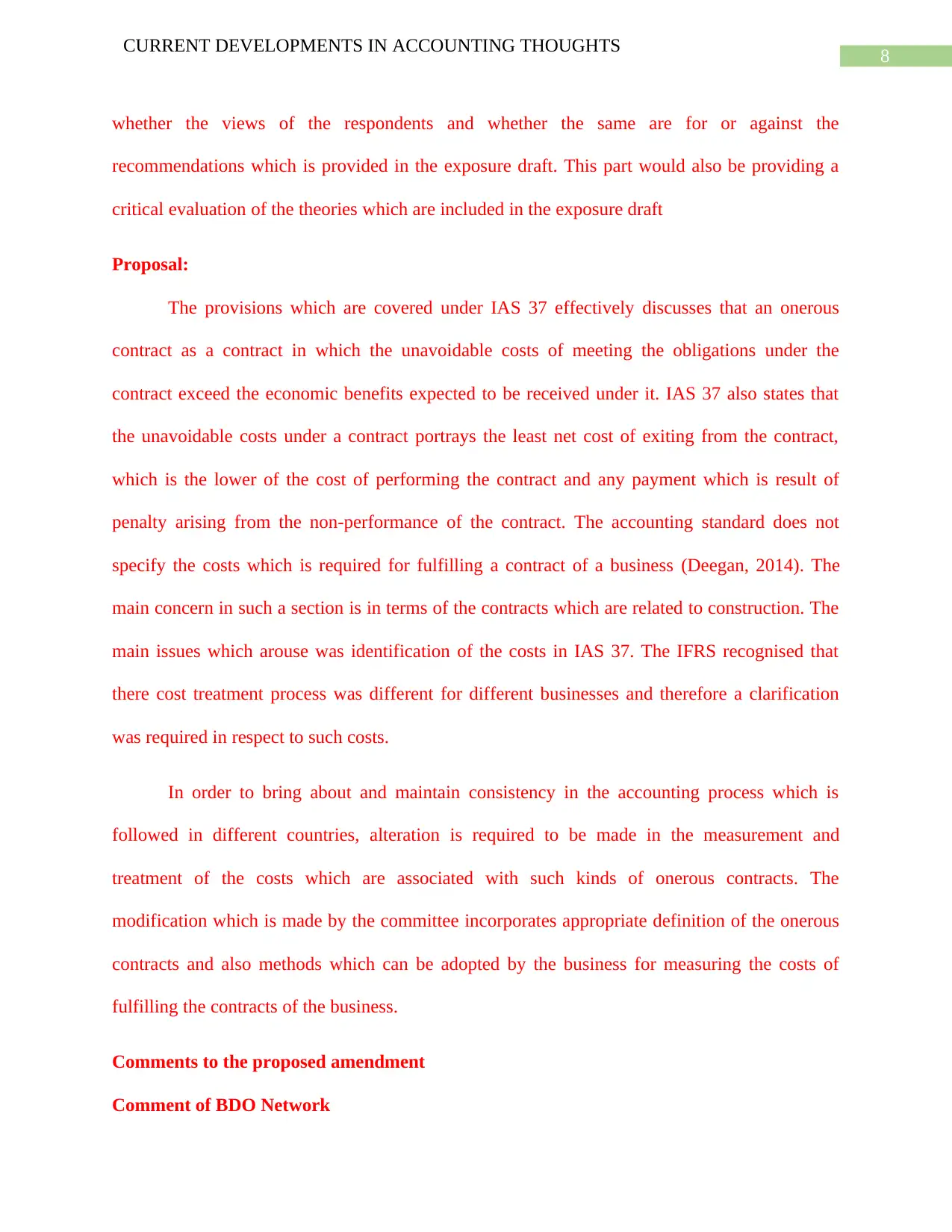
8
CURRENT DEVELOPMENTS IN ACCOUNTING THOUGHTS
whether the views of the respondents and whether the same are for or against the
recommendations which is provided in the exposure draft. This part would also be providing a
critical evaluation of the theories which are included in the exposure draft
Proposal:
The provisions which are covered under IAS 37 effectively discusses that an onerous
contract as a contract in which the unavoidable costs of meeting the obligations under the
contract exceed the economic benefits expected to be received under it. IAS 37 also states that
the unavoidable costs under a contract portrays the least net cost of exiting from the contract,
which is the lower of the cost of performing the contract and any payment which is result of
penalty arising from the non-performance of the contract. The accounting standard does not
specify the costs which is required for fulfilling a contract of a business (Deegan, 2014). The
main concern in such a section is in terms of the contracts which are related to construction. The
main issues which arouse was identification of the costs in IAS 37. The IFRS recognised that
there cost treatment process was different for different businesses and therefore a clarification
was required in respect to such costs.
In order to bring about and maintain consistency in the accounting process which is
followed in different countries, alteration is required to be made in the measurement and
treatment of the costs which are associated with such kinds of onerous contracts. The
modification which is made by the committee incorporates appropriate definition of the onerous
contracts and also methods which can be adopted by the business for measuring the costs of
fulfilling the contracts of the business.
Comments to the proposed amendment
Comment of BDO Network
CURRENT DEVELOPMENTS IN ACCOUNTING THOUGHTS
whether the views of the respondents and whether the same are for or against the
recommendations which is provided in the exposure draft. This part would also be providing a
critical evaluation of the theories which are included in the exposure draft
Proposal:
The provisions which are covered under IAS 37 effectively discusses that an onerous
contract as a contract in which the unavoidable costs of meeting the obligations under the
contract exceed the economic benefits expected to be received under it. IAS 37 also states that
the unavoidable costs under a contract portrays the least net cost of exiting from the contract,
which is the lower of the cost of performing the contract and any payment which is result of
penalty arising from the non-performance of the contract. The accounting standard does not
specify the costs which is required for fulfilling a contract of a business (Deegan, 2014). The
main concern in such a section is in terms of the contracts which are related to construction. The
main issues which arouse was identification of the costs in IAS 37. The IFRS recognised that
there cost treatment process was different for different businesses and therefore a clarification
was required in respect to such costs.
In order to bring about and maintain consistency in the accounting process which is
followed in different countries, alteration is required to be made in the measurement and
treatment of the costs which are associated with such kinds of onerous contracts. The
modification which is made by the committee incorporates appropriate definition of the onerous
contracts and also methods which can be adopted by the business for measuring the costs of
fulfilling the contracts of the business.
Comments to the proposed amendment
Comment of BDO Network
⊘ This is a preview!⊘
Do you want full access?
Subscribe today to unlock all pages.

Trusted by 1+ million students worldwide
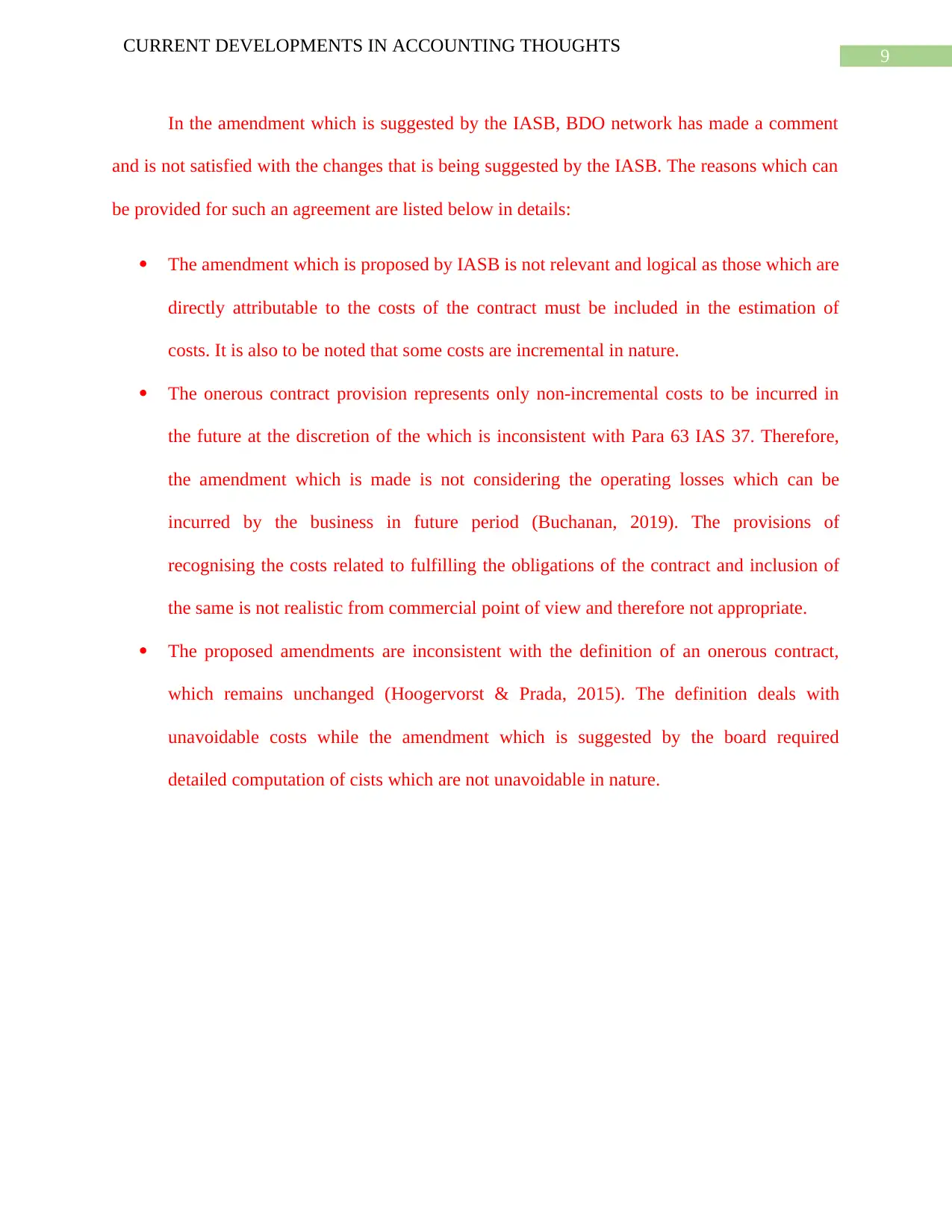
9
CURRENT DEVELOPMENTS IN ACCOUNTING THOUGHTS
In the amendment which is suggested by the IASB, BDO network has made a comment
and is not satisfied with the changes that is being suggested by the IASB. The reasons which can
be provided for such an agreement are listed below in details:
The amendment which is proposed by IASB is not relevant and logical as those which are
directly attributable to the costs of the contract must be included in the estimation of
costs. It is also to be noted that some costs are incremental in nature.
The onerous contract provision represents only non-incremental costs to be incurred in
the future at the discretion of the which is inconsistent with Para 63 IAS 37. Therefore,
the amendment which is made is not considering the operating losses which can be
incurred by the business in future period (Buchanan, 2019). The provisions of
recognising the costs related to fulfilling the obligations of the contract and inclusion of
the same is not realistic from commercial point of view and therefore not appropriate.
The proposed amendments are inconsistent with the definition of an onerous contract,
which remains unchanged (Hoogervorst & Prada, 2015). The definition deals with
unavoidable costs while the amendment which is suggested by the board required
detailed computation of cists which are not unavoidable in nature.
CURRENT DEVELOPMENTS IN ACCOUNTING THOUGHTS
In the amendment which is suggested by the IASB, BDO network has made a comment
and is not satisfied with the changes that is being suggested by the IASB. The reasons which can
be provided for such an agreement are listed below in details:
The amendment which is proposed by IASB is not relevant and logical as those which are
directly attributable to the costs of the contract must be included in the estimation of
costs. It is also to be noted that some costs are incremental in nature.
The onerous contract provision represents only non-incremental costs to be incurred in
the future at the discretion of the which is inconsistent with Para 63 IAS 37. Therefore,
the amendment which is made is not considering the operating losses which can be
incurred by the business in future period (Buchanan, 2019). The provisions of
recognising the costs related to fulfilling the obligations of the contract and inclusion of
the same is not realistic from commercial point of view and therefore not appropriate.
The proposed amendments are inconsistent with the definition of an onerous contract,
which remains unchanged (Hoogervorst & Prada, 2015). The definition deals with
unavoidable costs while the amendment which is suggested by the board required
detailed computation of cists which are not unavoidable in nature.
Paraphrase This Document
Need a fresh take? Get an instant paraphrase of this document with our AI Paraphraser
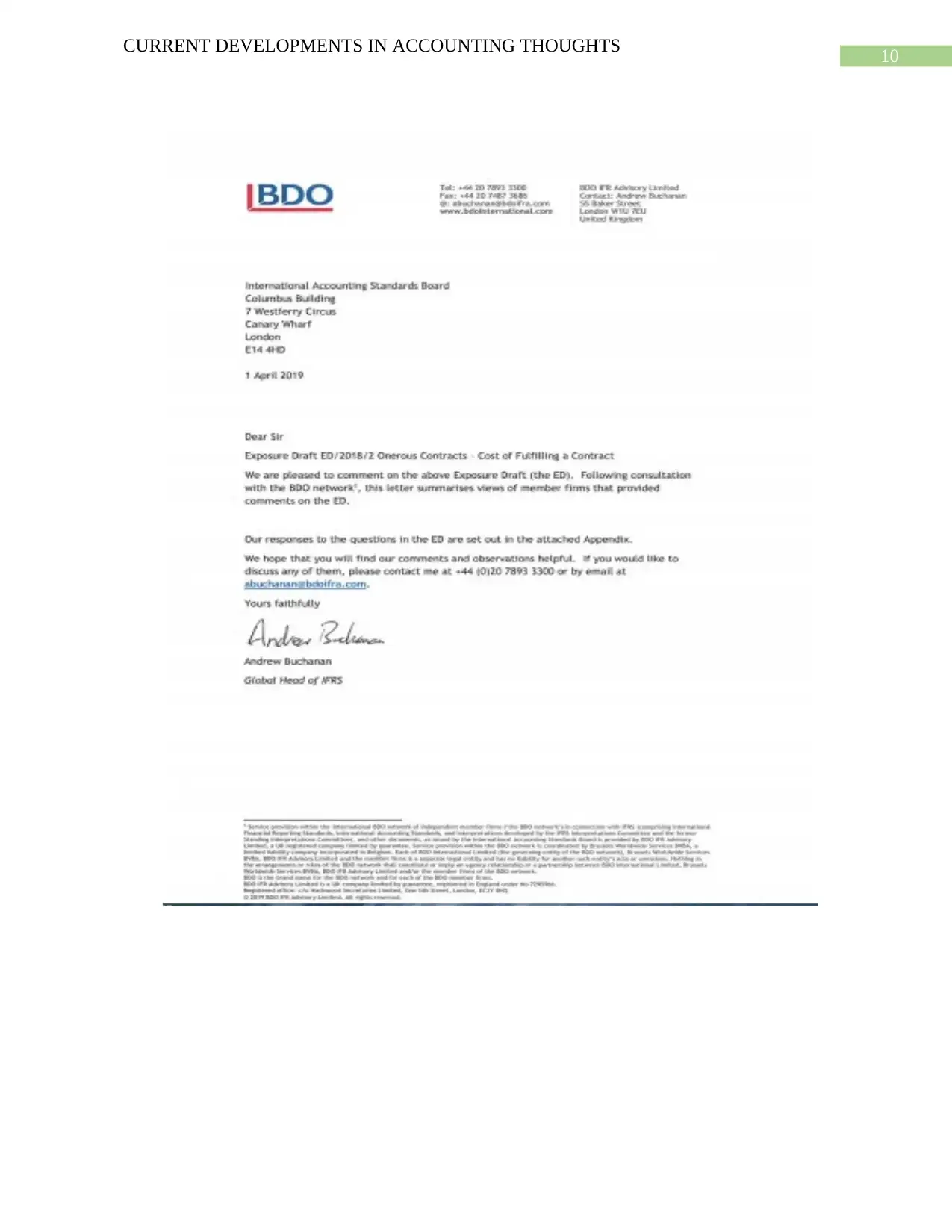
10
CURRENT DEVELOPMENTS IN ACCOUNTING THOUGHTS
CURRENT DEVELOPMENTS IN ACCOUNTING THOUGHTS
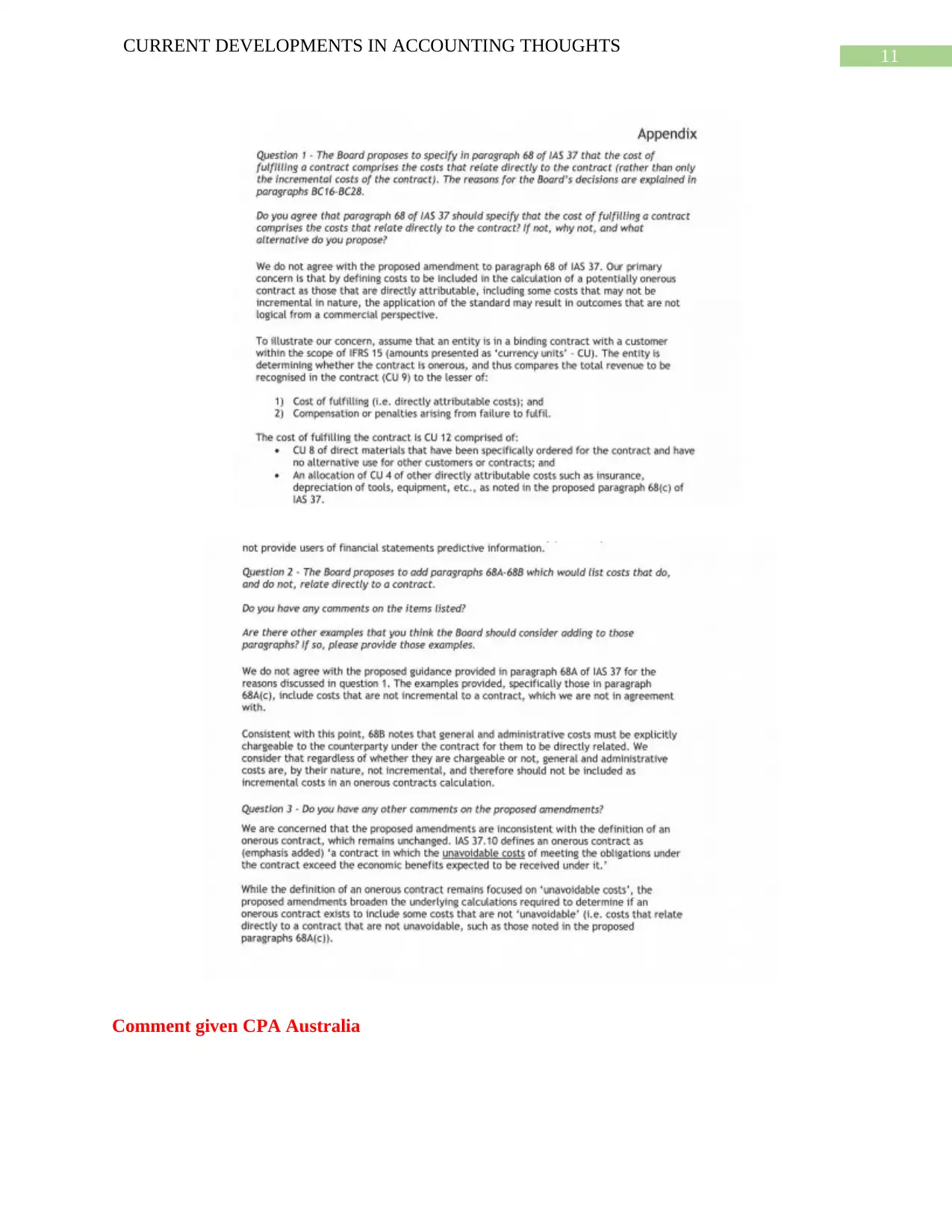
11
CURRENT DEVELOPMENTS IN ACCOUNTING THOUGHTS
Comment given CPA Australia
CURRENT DEVELOPMENTS IN ACCOUNTING THOUGHTS
Comment given CPA Australia
⊘ This is a preview!⊘
Do you want full access?
Subscribe today to unlock all pages.

Trusted by 1+ million students worldwide
1 out of 28
Related Documents
Your All-in-One AI-Powered Toolkit for Academic Success.
+13062052269
info@desklib.com
Available 24*7 on WhatsApp / Email
![[object Object]](/_next/static/media/star-bottom.7253800d.svg)
Unlock your academic potential
Copyright © 2020–2025 A2Z Services. All Rights Reserved. Developed and managed by ZUCOL.





